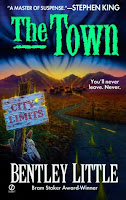
Another of the After Dark Festival’s Eight Films To Die For, Lake Dead is an unimaginative take on Texas Chainsaw Massacre. Two sisters inherit a hotel in a rural area from their grandfather, so they gather a group of friends, journey to the hotel and…go camping. I didn’t understand that either. The two sisters are blondes, reminded me of the Hilton Sisters. They are prettier, and probably smarter, though Lord, they are as dumb as posts. Their companions seem bright only by comparison.
It seems the folks running the hotel kill everyone who stays there. I don’t know why, it would seem this would be terrible for business. (In an amusing footnote that probably illustrates how depraved I am, I got the boxcover description mixed up with another movie, and thought they were supposed to be cannibals. So all through the flick, while they were dumping bodies into the lake and whatnot, all I could think was “Gee, they sure are wasting a lot of meat.”). They want to keep their bloodlines pure, so they kill everyone not related to them, and want to keep the sisters (who are the blondes, hope I didn’t spoil anything for you) for breeding purposes. There has been a great deal of incest (one of the scenes includes a sloppy French kiss between a man and his elderly mother, which elicits an eeeew and indicates the screenwriter may be from
For what it is, I guess the movie is okay. It features a number of nubile young folks killed in grotesque ways, and if that’s what you’re looking for, you’ll find it. It has way too many examples of one of my pet peeves: When the victims are fleeing the inbred killer mutants, they immediately drop any weapons they acquire, including a shotgun and pistol. I know a shotgun is heavy, but if I’ve got one and the guy chasing me has an axe, I won’t feel the urgency to run so fast. More of a saunter, really.
One other thing that slightly bugs me: although the movie is not set in the South, all the characters have pronounced Southron accents, which is typical of movies. If it has a rural setting, whether it’s upstate




















